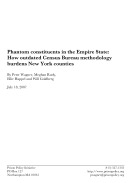
Importing Constituents:
Prisoners and Political Clout in Wisconsin
By John Hejduk and Peter Wagner
Prison Policy Initiative
March 2008
Section:
III. Redistricting and “One Person, One Vote”
III. A. Diluting votes on the state level
Be sure to read the Redistricting and One Person One Vote introduction to this section where John and I explain why federal and state law consider districts of equal population to be so important.—Peter Wagner
In Wisconsin, a State Assembly district is supposed to contain 54,179 people, and — according to the Census — each district is close to that size. But the federal judges who drew the districts relied on Census data which counted people in prison in the wrong place.
The population in Assembly District 42, represented by J. A. Hines (R), includes 2,052 prisoners as 3.8% of its population. Of those, the 1,277 prisoners in the Federal Correctional Institution at Oxford are not even necessarily from the state of Wisconsin, or even physically located in the district. The Census Bureau mistakenly counted the prison in Oxford even though it is actually 12 miles away in Adams County.
District 53, represented by Carol Owens (R), is even more distorted by the Census methodology: it contains 5,131 prisoners from other parts of the state who were counted as residents of District 53. The actual population of the district is 48,905, 9.7% smaller than it should be. Using Census counts of prisoners to pad out the district gives each group of 9 residents in District 53 as much political power as 10 residents elsewhere in the state.
According to the Census, District 53 is 4.3% Black, a larger percentage than 81 other districts. But 90% of the 2,342 Blacks in the district are actually incarcerated people from other parts of the state.
Using inaccurate data to draw legislative districts creates a vote dilution problem in Wisconsin that is slightly larger than that allowed by the U.S. Supreme Court [16] and 5 times larger than that allowed by the federal judges who have for decades drawn Wisconsin's state legislative districts.
The most affected districts are listed in Table 1, and information on all Assembly districts is listed in Appendix A.
| District | Representative (2008) | Prisoners (state and federal) | District population | Population Deviation | Percent of district that is incarcerated | Percent deviation without prisoners |
|---|---|---|---|---|---|---|
| 53 | Carol Owens | 5,131 | 54,036 | -143 | 9.5% | -9.7% |
| 42 | J.A. Hines | 2,052 | 54,206 | 27 | 3.8% | -3.7% |
| 4 | Phil Montgomery | 1,936 | 54,428 | 249 | 3.6% | -3.1% |
| 27 | Steve Kestell | 1,240 | 53,907 | -272 | 2.3% | -2.8% |
| 62 | Cory Mason | 1,405 | 54,049 | -130 | 2.6% | -2.8% |
| 91 | Barbara Gronemus | 0 | 54,596 | 417 | 0.0% | 0.8% |
| 76 | Terese Berceau | 0 | 54,619 | 440 | 0.0% | 0.8% |
| 14 | Leah Vukmir | 0 | 54,596 | 417 | 0.0% | 0.8% |
| 95 | Jennifer Shilling | 0 | 54,625 | 446 | 0.0% | 0.8% |
| 38 | Joel Kleefisch | 0 | 54,602 | 423 | 0.0% | 0.8% |
The Census methodology also distorts Senate districts. Almost 4% of District 18, represented by Carol Roessler (R), is the 6,110 prisoners at facilities in Waupun, Oshkosh and Fond du Lac. See Appendix B for a table of prison populations in all Senate districts.
Footnotes
[16] White v. Regester, 412 U.S. 755 (1973).



